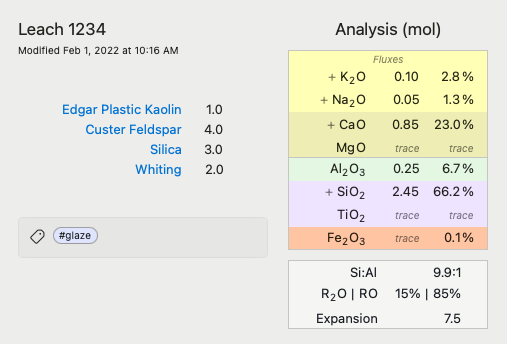Oxide Analysis
Suppose you see a faded glaze recipe scrawled on an old studio wall, "Leach 1234"
- Kaolin 1
- Whiting 2
- Silica 3
- Feldspar 4
And you think "Hmmmm, what might this ancient glaze recipe be good for?"
After entering it into Mixup you see:

The analysis tallies up the oxides and tells you the inside story. The first thing to note is the "(mol)", which indicates that this analysis is in terms of molecule count, or mols, and not by weight. Some molecules are heavier than others, but a heavy molecule isn't necessarily more active or important than a light one. It makes more sense to look at oxides in terms of molecule count, not by how much they weigh.
There are two ways to present the molecule tally: Percent and Unity. The second column is percent and is easy enough to understand. In this glaze for example 23% of the molecules are calcia. All the molecules total up to 100%.
Another way to scale the numbers is to make all the flux molecules to sum to one. It's known as a Unity Molecular Formula and is the first column of numbers in the analysis. For a unity formula any oxide amount is in proportion to all the fluxes, or the unity of fluxes. In this case the calcia is 0.85, or 0.85 calcia molecules for every flux molecule. In other words calcia is 85% of the fluxes. Silica is 2.45, so there are 2.45 silica molecules for every flux molecule.
Unity Molecular Formula (aka UMF) is also known as Seger Formula. In UMF the fluxes will add to one but the other oxides can range. Unity formula is a great way to see what the ratio of flux to other oxides is. In this case we see 0.25 mols of alumina (adequate) and 2.45 mols of silica. Without boron to help things melt though this is probably a high temperature glaze, even though silica is 2.45, which isn't much compared to other high temperature glazes.
Both columns show the same relative amounts, so in that sense they are the same. The first column scales the mols so that the fluxes sum to 1. The second column scales the mols so the grand total is 100%. Same counts of molecules, but different scales.
